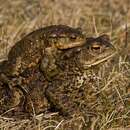en
names in breadcrumbs


Unlike other Egyptian toads this is a highly aquatic species. Nocturnal, but calling males can often be heard throughout the day, particularly in spring and autumn. Usually detected by its distinctive call.The species appears highly secretive; males calling at very close range are almost impossible to locate. Often in very dense populations, especially in rice fields, where up to 6 animals were observed within a 0.5 m2 area.
Least Concern
A small toad; SVL of males up to 34 mm, of females up to 38.5 mm. Snout relatively short, slightly pointed; paratoids indistinct, spinose, oval; tympanum relatively large, 0.68-0.86 of eye diameter, and set very close to it. Back notably granular, spinose; ventral sides granular. Second finger longer than first; hind limbs short, with limited webbing between digits; tarsal ridge absent. Males with a subgular vocal sac. Dorsum light olive gray with paired dark marks in the interorbital, pectoral, and sacral regions, often a thin whitish, mid-dorsal line. Crimson femoral patches of variable size are present. Ventral sides white, sometimes with dark flecks; throat pale orange in males. Adult males are usually suffused yellow, with a reduced dorsal pattern, and are notably more spinose than females. Call simple, rattle-like. Call characteristics: average pulses/call = 3.46; average call duration = 119.88 ms.
The Nile Valley and Delta, and the Fayoum Depression. The species was previously thought to be confined to the Delta (Baha El Din 1993), but seems to have spread upstream along the Nile River, probably as a result of the establishment of extensive reed swamps along the riverbanks and canals, after the completion of the High Dam. The species can be heard regularly along the Nile even in the middle of Cairo, and abundant populations were recently discovered in the Luxor region.
Apparently endemic to Egypt.
Prefers densely vegetated microhabitats in shallow or deep water. In reed swamps, rice fields, overgrown canals, and waterways; even in floating clumps of vegetation in the middle of the Nile. Only once observed on dry land, when several animals were encountered in a newly ploughed field (a rice field being prepared) at midday near Damietta.
Common but localized.
Bufo is a genus of true toads in the amphibian family Bufonidae. As traditionally defined, it was a wastebasket genus containing a large number of toads from much of the world, but following taxonomic reviews most of these have been moved to other genera, leaving only seventeen extant (living) species from Europe, northern Africa and Asia in this genus, including the well-known common toad (B. bufo).[1] Some of the genera that contain species formerly placed in Bufo are Anaxyrus (many North American species), Bufotes (European green toad and relatives), Duttaphrynus (many Asian species, including the Asian common toad introduced elsewhere), Epidalea (natterjack toad) and Rhinella (many Latin American species, including the cane toad introduced elsewhere).[2]
True toads have in common stocky figures and short legs, which make them relatively poor jumpers. Their dry skin is thick and "warty".
Behind their eyes, Bufo species have wart-like structures, the parotoid glands. These glands distinguish the true toads from all other tailless amphibians. They secrete a fatty, white poisonous substance which acts as a deterrent to predators. Contrary to folk belief, handling toads does not cause warts, however due to the poison they secrete, and bacteria on their skins, a person should wash their hands thoroughly after handling one.[3] The poison of most if not all toads contains bufotoxin.
Formerly, the genus Bufo encompassed many species and was divided into several subgenera. Frost et al. (2006) removed most of the species of former Bufo to other genera and restricted the name Bufo to members of the Bufo bufo group of earlier authors.[2] Now, this genus has been reduced to seventeen extant species:[1]
Binomial name and author Common name Bufo ailaoanus Kou, 1984 Ejia toad, Ailao toad Bufo aspinius (Yang, Liu, and Rao, 1996) Bufo bankorensis Barbour, 1908 Central Formosa toad, Bankor toad Bufo bufo (Linnaeus, 1758) Common toad, European toad Bufo cryptotympanicus Liu & Hu, 1962 Earless toad Bufo eichwaldi Litvinchuk, Borkin, Skorinov, and Rosanov, 2008 Eichwald's toad Bufo gargarizans Cantor, 1842 Chusan Island toad, Asiatic toad Bufo japonicus Temminck and Schlegel, 1838 Japanese toad †Bufo linquensis Yang, 1977 Bufo luchunnicus (Yang and Rao, 2008) Luchun stream toad Bufo menglianus (Yang, 2008) Menglian stream toad Bufo pageoti Bourret, 1937 Tonkin toad Bufo scorteccii Balletto and Cherchi, 1970 Scortecci's toad Bufo spinosus Daudin, 1803 Spiny toad Bufo stejnegeri Schmidt, 1931 Stejneger's toad, Korean toad, Water toad Bufo torrenticola Matsui, 1976 Honshū toad, Japanese stream toad Bufo tuberculatus Zarevskij, 1926 Qinghai Lake toad, Round-warted toad Bufo tuberospinius (Yang, Liu, and Rao, 1996) Bufo verrucosissimus (Pallas, 1814) Caucasian toadBufo is a genus of true toads in the amphibian family Bufonidae. As traditionally defined, it was a wastebasket genus containing a large number of toads from much of the world, but following taxonomic reviews most of these have been moved to other genera, leaving only seventeen extant (living) species from Europe, northern Africa and Asia in this genus, including the well-known common toad (B. bufo). Some of the genera that contain species formerly placed in Bufo are Anaxyrus (many North American species), Bufotes (European green toad and relatives), Duttaphrynus (many Asian species, including the Asian common toad introduced elsewhere), Epidalea (natterjack toad) and Rhinella (many Latin American species, including the cane toad introduced elsewhere).